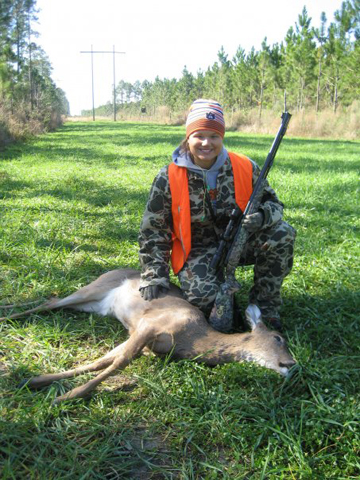
Season helps ensure healthy deer population
By Stan Kirkland, FWC
Back in the 1960s and 1970s, the idea of an antlerless deer season in Florida would have been met with skepticism. After all, it was during that time when deer were being released in different areas around the state in an effort to rebuild populations.
Hunters know this better than anyone, but the recovery is long since complete and antlerless deer hunting is now an accepted and necessary deer management practice.
Beginning Monday Dec. 26, and extending through Jan. 1, 2012, gun hunters who hunt private lands can take deer of either sex, except spotted fawns, in Zones B and D. The seven-day antlerless deer season comes on the heels of a month-long archery and crossbow season, when both bucks and does were legal.
The Florida Fish and Wildlife Conservation Commission (FWC) divides Florida into Zones A – D for setting deer seasons. Zone D includes most of the Florida Panhandle. Zone B is a multicounty swath of land in west-central Florida near Tampa.
“The antlerless deer season gives people with small pieces of land the opportunity to hunt deer of either sex on their property, and manage their deer, just like landowners with abundant acreage who qualify for antlerless deer permits,” said Cory Morea, the FWC’s deer management program coordinator.
He said that when deer become too plentiful there can be problems. Most often deer numbers exceed the social carrying capacity – the number of deer people will tolerate – long before they exceed the biological carrying capacity of the land, according to Morea.
Like most states, he said, Florida estimates how many deer are killed each season. For the 2010-11 hunting season, Florida hunters reported taking approximately 103,000 bucks and 75,700 does.
While accurate numbers of Florida’s deer population aren’t known, Morea said, “It’s fair to say the population is healthy and in good shape.”
The antlerless deer season is a good time to introduce a young hunter to deer hunting. A few years ago, my friend, John, invited Sarah, my 16-year-old daughter, and me to his place in north Bay County for a hunt, in the hopes Sarah could get a doe. He and the other owner like to remove 20-25 does each year off their tract.
The morning of our hunt, it was 18 degrees when we pulled into the property. Thankfully, there was no wind. Sarah and I positioned ourselves in a small, elevated, enclosed stand, about midway on a green food plot.
We saw five beautifully antlered bucks before a doe ever made her way into the plot. When the “doe” got within 40 yards, Sarah made a perfect shot with her .45 caliber muzzleloader.
It wasn’t until we got a close look at her deer that we discovered her doe was actually a 6-month-old buck without antlers. Her buck weighed 100 pounds and became sausage, hamburger and steak.
Even though her deer wasn’t a doe, the landowners were happy for her. And, her deer, which falls under the antlerless deer category, helped them accomplish their management goals.
Like many kids, Sarah had a good experience and still hunts with me today.
